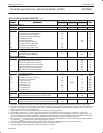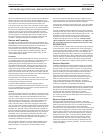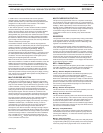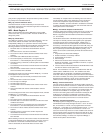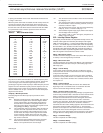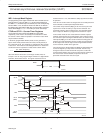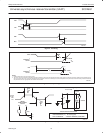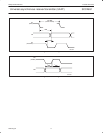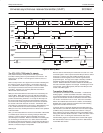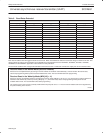
Philips Semiconductors Product data sheet
SCC2691Universal asynchronous receiver/transmitter (UART)
2006 Aug 04
13
CR[1] – Disable Receiver
This command terminates operation of the receiver immediately; a
character being received will be lost. The command has no effect on
the receiver status bits or any other control registers. If the special
wake-up mode is programmed, the receiver operates even if it is
disabled (see Wake-up Mode).
CR[0] – Enable Receiver
Enables operation of the receiver. If not in the special wake-up
mode, this also forces the receiver into the search for start bit state.
SR – Channel Status Register
The status register is updated while RDN is negated. Therefore, the
bus interface used with this device must not use a static RDN line.
The RDN line must be pulsed to allow status register updates.
SR[7] – Received Break
This bit indicates that an all zero character of the programmed
length has been received without a stop bit. Only a single FIFO
position is occupied when a break is received; further entries to the
FIFO are inhibited until the RxD line returns to the marking state for
at least one half bit time two successive edges of the internal or
external 1X clock. This will usually require a high time of one X1
clock period or 3 X1 edges since the clock of the controller is
not synchronous to the X1 clock.
When this bit is set, the change in break bit in the ISR (ISR[3]) is
set. ISR[3] is also set when the end of the break condition, as
defined above, is detected.
The break detect circuitry is capable of detecting breaks that
originate in the middle of a received character. However, if a break
begins in the middle of a character, it must last until the end of the
next character time in order for it to be detected.
SR[6] – Framing Error (FE)
This bit, when set, indicates that a stop bit was not detected when
the corresponding data character in the FIFO was received. The
stop bit check is made in the middle of the first stop bit position.
SR[5]– Parity Error (PE)
This bit is set when the with parity or force parity mode is
programmed and the corresponding character in the FIFO was
received with incorrect parity. In special wake-up mode, the parity
error bit stores the received A/D bit.
SR[4] – Overrun Error (OE)
This bit, when set, indicates that one or more characters in the
received data stream have been lost. It is set upon receipt of a new
character when the FIFO is full and a character is already in the
receive shift register waiting for an empty FIFO position. When this
occurs, the character in the receive shift register (and its break
detect, parity error and framing error status, if any) is lost. This bit is
cleared by a reset error status command.
SR[3] – Transmitter Empty (TxEMT)
This bit will be set when the transmitter underruns, i.e., both the
TxEMT and TxRDY bits are set. This bit and TxRDY are set when
the transmitter is first enabled and at any time it is re-enabled after
either (a) reset, or (b) the transmitter has assumed the disabled
state. It is always set after transmission of the last stop bit of a
character if no character is in the THR awaiting transmission.
It is reset when the THR is loaded by the CPU, a pending
transmitter disable is executed, the transmitter is reset, or the
transmitter is disabled while in the underrun condition.
SR[2] – Transmitter Ready (TxRDY)
This bit, when set, indicates that the THR is empty and ready to be
loaded with a character. This bit is cleared when the THR is loaded
by the CPU and is set when the character is transferred to the
transmit shift register. TxRDY is reset when the transmitter is
disabled and is set when the transmitter is first enabled, e.g.,
characters loaded in the THR while the transmitter is disabled will
not be transmitted.
SR[1] – FIFO Full (FFULL)
This bit is set when a character is transferred from the receive shift
register to the receive FIFO and the transfer causes the FIFO to
become full, i.e., all three FIFO positions are occupied. It is reset
when the CPU reads the FIFO and there is no character in the
receive shift register. If a character is waiting in the receive shift
register because the FIFO is full, FFULL will be reset by the CPU
read and then set by the transfer of the character to the FIFO, which
causes all three FIFO positions to be occupied.
SR[0] – Receiver Ready (RxRDY)
This bit indicates that a character has been received and is waiting
in the FIFO to be read by the CPU. It is set when the character is
transferred from the receive shift register to the FIFO and reset
when the CPU reads the RHR, and no more characters are in the
FIFO.
ACR – Auxiliary Control Register
ACR[7] – Baud Rate Generator Set Select
This bit selects one of two sets of baud rates generated by the BRG.
Set 1: 50, 110, 134.5, 200, 300, 600, 1.05k, 1.2k, 2.4k, 4.8k, 7.2k,
9.6k, and 38.4k baud.
Set 2: 75, 110, 134.5, 150, 300, 600, 1.2k, 1.8k, 2.0k, 2.4k, 4.8k,
9.6k, and 19.2k baud.
The selected set of rates is available for use by the receiver and
transmitter. See Table 3 for characteristics of the BRG.
ACR[6:4] – Counter/Timer Mode and Clock Source Select
This field selects the operating mode of the counter/timer and its
clock source as follows:
Table 4. ACR[6:4] Operating Mode
ACR [6:4] Mode Clock Source
0 0 0 Counter MPI pin
0 0 1 Counter MPI pin divided by 16
0 1 0 Counter
TxC–1X clock of the
transmitter
0 1 1 Counter
Crystal or X1/CLK divided
by 16
1 0 0 Timer (square wave) MPI pin
1 0 1 Timer (square wave) MPI pin divided by 16
1 1 0 Timer (square wave)
Crystal or external clock
(X1/CLK)
1 1 1 Timer (square wave)
Crystal or X1/CLK divided
by 16
The timer mode generates a squarewave.
ACR[3] – Power-Down Mode Select
This bit, when set to zero, selects the power-down mode. In this
mode, the SCC2691 oscillator is stopped and all functions requiring
this clock are suspended. The contents of all registers are saved. It
is recommended that the transmitter and receiver be disabled prior




